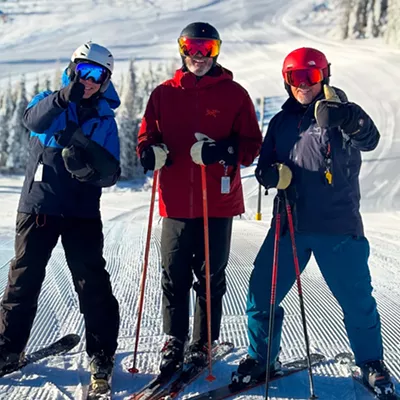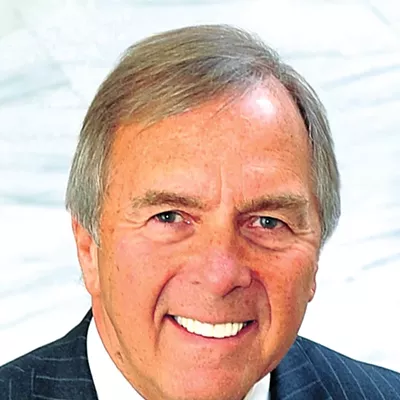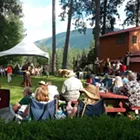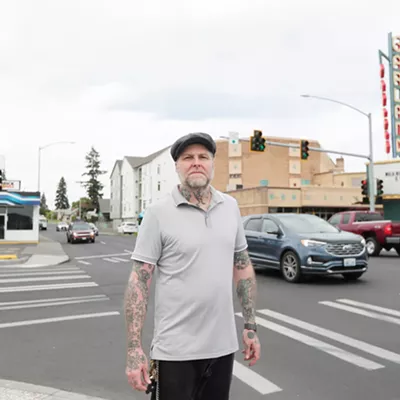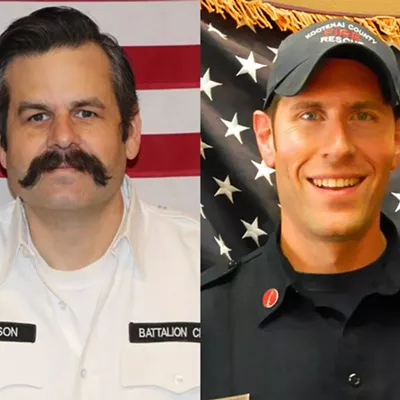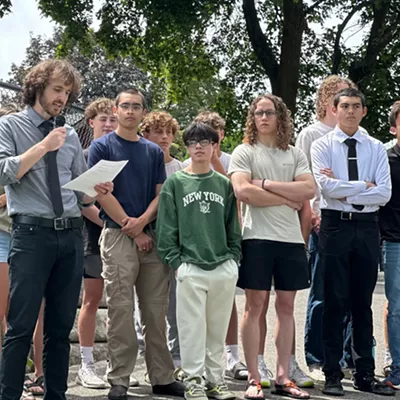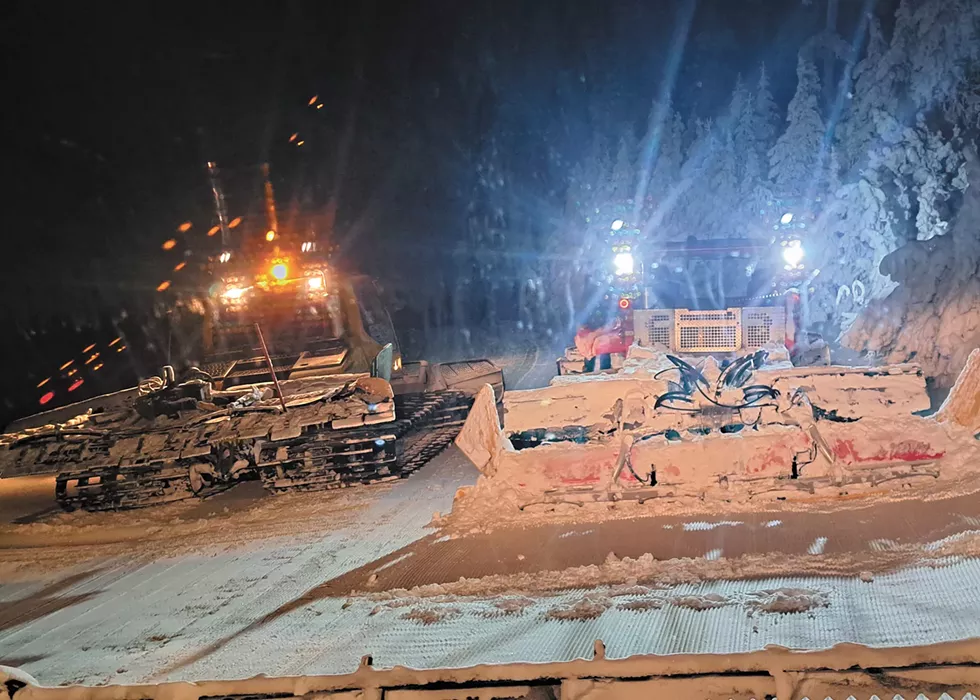
On a clear summer's day, the top of Mount Spokane is a spectacular place. At 5,887 feet, it's the tallest point in Spokane County. Marking the southern tip of the Selkirk Range, it looks out upon the lakes of North Idaho, the Palouse, the Columbia Plateau and the sprawling expanse of metropolitan Spokane below. But in the darkest days of winter, it can be a different story. And on this day — Saturday, Dec. 17, 2022 — sunset came before 4 pm, and a thick fog blanketed the landscape.
Down lower on the mountain, the Mt. Spokane Ski & Snowboard Park was open for night skiing. With the evening session just underway, Mt. Spokane Ski Patrol Director Kristin Whitaker stepped inside the patrol warming hut above Chair 2 around 6 pm.
"It was not ideal conditions," Whitaker recalls. "It was freezing sleet, and things were starting to cover with ice. We were regrouping, drying off."
Then came an urgent radio call for help.
"It was a code for Northwood [Chair 6, one of the lifts serving the backside of the mountain]," she recalls, "and they were requesting transport, a trauma kit and oxygen. We just looked at each other in a bit of shock, knowing Northwood is not open to night skiing."
Northwood was over the top of the mountain from where they were — uphill. So Whitaker and another patroller packed up the heavy rescue gear and their skis and started "hoofing it" up to the scene as fast as they could. Soon, out of the pitch black, two sets of lights came into focus: Grooming machines were working that part of the mountain to get the snow tuned up for the next day's skiers.
"That six-, seven-minute hike, the whole time I was praying for the strength to get through," Whitaker says. "I didn't know everything the scene would reveal, but I did know it was one of my brothers."
They found one of the groomer drivers crouching over the other, who was laying in the snow. It was a confusing scene, but soon became horribly clear: He had accidentally been run over by the groomer, all 20,000 pounds of it.
"He was in really rough shape," Whitaker says. "But that's when our training kicked in. Airway, breathing, circulation — that's where we go immediately.
"What was totally deceiving about it was that he was talking to us — he was conscious. He was kind of even joking here and there."
The man laid out in this unforgiving, remote place, cracking jokes in the middle of a desperate fight for his life? That man was indeed a beloved brother — to Whitaker and so many other people spread across Spokane. It was Mark Starr.
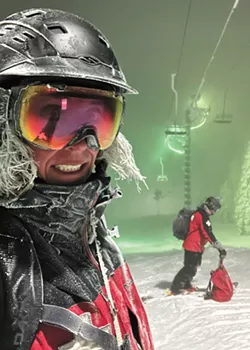
"I COULD HAVE DIED"
Mark Starr is a local legend. "Compassionate," "generous," "positive" — those are the words people use to describe him. I can personally vouch for these and more, as we've known each other for many years. He's earned that praise with his longstanding devotion to so many community events (Bloomsday, for starters) and charitable efforts (Spokane Fantasy Flight among so many others). And, when necessary, he can toss a perfect pizza crust. As the owner of Spokane institution David's Pizza, he's fed a lot of hungry people since starting up in the early 1990s. You may know him from the old fire truck he's converted into a mobile pizza oven, which he hauls out to pitch in where he can — even feeding firefighters on the front lines.
"First of all, I could have died," Starr says, right around the one-year anniversary of his accident. "I'm lucky to be here."
Starr has never told his story in detail until now: "I never wanted anyone to worry about me," he explains. "That's super important to me."
But now, with the passing of time, his gratitude compels him to share what is both the story of one man's fight to survive, and also a tribute to all the first responders, close friends and medical professionals who kept him alive — and helped get him back on his feet.
"I'm so thankful...," he says, his voice trailing off, the memories of a very tough year seemingly taking the place of mere words.
“In the [Aid Room], the looks on peoples’ faces as they started to cut my pants off, I could see the color drop out of their faces. That’s when I could tell my leg was a mess.”— Mark Starr
PICK UP, HAUL ASS
Back on top of Mount Spokane, those first on the scene did some basic stabilization as more patrollers arrived. One thing started to come to the front of everyone's mind: the clock, ticking away. One of the key elements of any rescue is time.
"There's an acronym we use in ski patrol," says Whitaker. "PUHA. That's 'pick up and haul ass' — get 'em down the mountain as quick as we can. And that's what we did."
Radio dispatch had already alerted Fire Districts 4 and 9, along with Life Flight. The fog made a helicopter rescue impossible, but a massive response set out from Station 44 in Colbert for the upper parking lot at the ski resort — the tech rescue team, a paramedic unit, incident commanders, two engines and an AMR ambulance.
But first they had to get Starr into a toboggan, and he was in massive pain with shock coming on. When they found a position he could tolerate, they strapped him in, hooked the sled to the back of a snow machine and, in Starr's words, "They hauled my butt down the mountain."
Thanks to generations of devoted ski patrollers serving the Mt. Spokane ski area, a charming ski shack exists just east of the Main Lodge. Funded by donations and built by patrol volunteers, the Ski Patrol Building is a tribute to an organization founded in 1938 — the 17th registered ski patrol in the nation and one of the few remaining all-volunteer ski patrols.
"We've always had a culture of training," says Whitaker. Volunteers are teachers, doctors, stay-at-home moms; Whitaker is a marketing professional with 15 years on the patrol. They log hundreds of hours training for whatever the day may bring. "And on nights like that," she says, "it really pays off."
In the lower level of the Ski Patrol Building they built a mini hospital — the Aid Room — which is where they brought Starr to tend to him as they waited for additional help to arrive.
Remarkably, Starr had remained conscious and was worried about those responding more than himself.
"I remember making a conscious decision to stay awake," he recalls. "I was trying to hold my shit together to not make anyone panic."
Nonetheless, worry washed over the cramped room as the extent of his injuries was revealed.
"In the [Aid Room], the looks on peoples' faces as they started to cut my pants off, I could see the color drop out of their faces. That's when I could tell my leg was a mess."
Just surviving the accident was a miracle; staying awake through the aftermath, uncanny. The list of injuries, once fully tallied over the coming days, was shocking.
"First of all, this was an accident, no dangerous behavior," says Starr. "No one is to blame — a malfunction of machinery."
Recounting it all a year later, he remembers the series of events clearly. They had groomed a ton of ground early in their shift; they had stopped to survey the next places to hit. Starr got out of his rig — with just a T-shirt and Carhartt vest, as the cabins are heated. He was talking to his co-worker when suddenly the machine lurched ahead and his feet were trapped; quickly the chassis knocked him onto his back.
"I could see it coming," he says, "then the machine just rolled over the top of me."
The tracks of the groomers are like those on military tanks — each 5 feet wide, with 4-inch metal cleats added for traction. When he felt it getting close to his head, he realized he could swing his arm up to protect himself, which probably saved his life. (The outline of his wristwatch was imprinted on his forehead.) Eventually, the machine passed over him, but in a scene out of a James Bond movie, he realized that the metal tiller — the business end of the groomer — was coming fast. In a burst of energy, somehow forcing limbs that did not respond, he managed to roll out of the way. That was about when the machine was brought back under control and stopped.
Starr's left leg bore the brunt of it: His calf muscle was ripped from the bone; the ligaments in his knee were shredded. Among his 25 fractures, the arm that he pulled over his head was broken, along with his ribs and pelvis. His lung was punctured and had collapsed, so within minutes of the accident he couldn't talk; he doesn't know why, but for a while just afterwards, he was blind. His scalp was partially torn off.
Only part of that list was evident as his co-worker jumped down to cover him from the cold, staying calm while the patrollers raced uphill to their position. Starr had kept his cellphone inside the pocket of his vest. It was bent nearly in half.
“Having a leg or not having a leg is pretty significant. Mark said to me, ‘Whatever you need me to do to save this leg, I will do it.’”— Dr. Laura Bonneau
THE GOLDEN HOUR
As the patrollers were discovering the horror of Starr's injuries, the cavalry had arrived after a run up the switchbacks to the parking lot. It was 7:18 pm. Not knowing exactly what they would find, the trauma team — a collaboration between Fire Districts 4 and 9 — was ready for whatever would come. But there would be no need for the jaws of life or a scramble up the mountain; the all-volunteer Mt. Spokane Ski Patrol had the patient as stable as they could manage and ready for transport.
Starr believes they had him from accident to ambulance in an hour — staying within that all-important golden hour first responders aim for.
Next stop: the Sacred Heart ER.
Over the more than hourlong drive, the paramedics in the ambulance stabilized Starr further, working on stopping his loss of blood and likely providing more pain meds. Starr did lose consciousness on the ride down.
Trauma teams have a name for what happened that night: complex polytrauma. It's like what happens to victims of motorcycle wrecks. It was also a preview of the accident actor Jeremy Renner would endure less than two weeks later, when he was run over by his own snowplow in Nevada — an event that continues to make international news.
As soon as the call came into the ER about an incoming polytrauma, Andrew Howlett — one of the orthopedic surgeons at the head of the spear of the Sacred Heart trauma team — was called in. To those outside the medical profession, it all can sound pretty daunting, but Dr. Laura Bonneau, who treated Starr after the trauma team, says it's more routine than people may think.
"They deal with this stuff all the time," she says. "The degree of medical and surgical competence here is so high."
Starr survived his journey to the hospital; crucially, somebody along the way did their job and stuck a needle in his chest to allow his completely collapsed lung to expand. The trauma team at the ER would have immediately put in a chest tube to get past the blood and allow the lungs to function better. What to do about that left leg would be a decision for later; instead, they attacked his more pressing injuries.
His forearm was repaired, along with his left knee and pelvis (which would require another surgery later). His scalp was reattached.
As the first night of the accident drew to a close, his road to recovery was just starting.
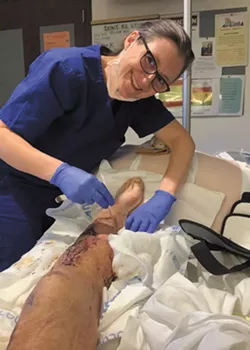
DOING THEIR JOBS
Soon Bonneau, a reconstructive plastic surgeon, was called in to take a look at that leg. She had heard from her ortho colleagues that he was beat up pretty bad.
"I got a call from a mutual friend of Mark's, and he said, 'Hey, people are starting to talk about amputation, and Mark's not having it,'" she says. "And from the second I met him, I thought, 'This is not the average polytrauma.' He's sucking away on the incentive spirometer, taking big deep breaths, pulling 4 liters on the thing. I was like, 'OK, I have to reframe how I'm thinking about this. This guy is going to master this.'
"Having a leg or not having a leg is pretty significant," Bonneau adds. "Mark said to me, 'Whatever you need me to do to save this leg, I will do it.'"
So Bonneau and her team prepped up and went into a surgery that required two surgeons and seven supporting medical professionals. It lasted more than 12 hours.
Today, Mark Starr has both legs. He spent seven weeks in the hospital, with four of those flat on his back; it was another eight weeks in a hotel close to his caregivers. In total, he was 16 weeks in a wheelchair before he graduated to a walker. And it's still a long road back. He's had infections in that left knee (which took two surgeries to treat), with two more surgeries to come to repair what's left of the ligaments in it. He had to relearn how to walk with the team at U-District PT; his staff at David's kept the pizzas coming.
"I attribute a lot of my recovery to the talents of all those people who helped me," says Starr. "One of the talents was their positivity. They got behind me. I thought, 'This is in my court now.' I had to show that I mean what I say, that I would exceed their expectations."
You may have guessed it from how he attacked his rehab, but Starr is one of those "never-stop-never-stopping" kind of people. To drive home his point that nobody should worry about him, in March, two days post-wheelchair, he got behind the wheel and showed off his pizza truck in the St. Patrick's Day Parade. Like every other May, he helped pull off another Bloomsday; last month he was back flying around with the other elves on the Fantasy Flight.
Starr doesn't have a lot of family left, just a brother in Seattle and an aunt and uncle in Palm Desert, California. Ever since landing in Spokane in the late 1970s, from working for Pepsi, Huppin's Hi-Fi, then the legendary nightspot Strobel's and finally building David's Pizza, the entire city has become his family. But over the past year, with all they have gone through together, Mt. Spokane — a place that's been a part of his life for decades — feels more like home than ever, he says. And, yes, he's been back up running a groomer a couple times this season.
Whitaker is not surprised by the outpouring of encouragement that has come to the brother she came upon that dark and miserable night: "That's just Mark. What a positive, caring, generous person he is."
"I can't put it into words," Starr adds. "How supportive this community is, it's beyond inspiring. It just blows me away." ♦
A TOUGH BUSINESS
The Mt. Spokane Ski Patrol is made up of volunteers, but even for paid patrollers or first-responders who make a full-time career as firefighters, police or EMTs, the work can leave mental scars. Sometimes things don't go right. The injured don't always survive.
"I'm proud of how we performed that night," says Kristin Whitaker, Mt. Spokane Ski Patrol director, who was one of the first on the scene of Mark Starr's accident. "But in first-responder-world, there's a connotation that you should be tough, things shouldn't affect you. The blessings are that it caused the people who were on the scene that night to open up and start talking about what happened. It's OK to talk about these things with your peers, to have shoulders to cry on. We need to make it a culture of talking about these things."
When the ambulance departed the mountain, that's when it set in. Everyone — from those who were at the scene to those working elsewhere on the mountain that night — had gone through a trauma.
With Starr back on his feet, and with the shared need to talk about it, many of those who were there that night gathered exactly a year later, last month on Dec. 17, to be together up on the mountain to celebrate how everybody all down the line did their jobs and saved a precious life.
"We cheers'd each other, and we laughed as Mark made a lot of inappropriate jokes," Whitaker says. "It was therapeutic for all of us."
— TED S. McGREGOR JR.
JEREMY RENNER FEELS STARR'S PAIN
Less than two weeks after Mark Starr's accident, uncanny news reports came in of another accident involving a huge snow vehicle. Actor Jeremy Renner was run over at his home in Nevada by his snowplow. While Starr kept his story mostly to himself as he went through multiple surgeries and took the early steps toward recovery, Renner's story made international headlines. He is, after all, an Avenger, playing Hawkeye in the Marvel movies.
The similarities are eerie, from the accident itself to their recoveries. Both were pulled under and run over by massive, treaded machines. Renner's was a more than 14,000-pound machine, resulting in 30 broken bones; Starr's was closer to 20,000 pounds, breaking 25 bones. While Renner was airlifted to a hospital in Reno, Starr was evacuated from the top of Mount Spokane and rushed to the ER.
Both credit their friends and family for support in their recovery, with Renner keeping his fans updated on his Instagram page.
"My greatest therapy has been my mind and the will to be here and push to recover and be better," Renner wrote in one post, mirroring Starr's sentiments. "Be exceptional... I feel it's my duty to do so. Not to squander my life being spared, but to give back to my family, friends, and all of you whom have empowered me to endure. I thank you all."
Today, Starr is talking about his accident in detail for the first time, out of gratitude to all those who helped him. Both men marked the one-year anniversary by returning to the scenes to recognize those who helped save them — Starr with a small gathering at Mount Spokane, Renner thanking his caregivers in Reno.
The two have even more in common. Starr's David's Pizza oven truck (converted from an old fire truck) is well known across Spokane, but did you know that Renner's Foundation, RennerVation, owns a converted fire truck, too? He rolled up to the hospital in Reno, smiling from the cab, handing out "joy, blessings and" — wait for it — "pizza."
— TED S. McGREGOR JR.






